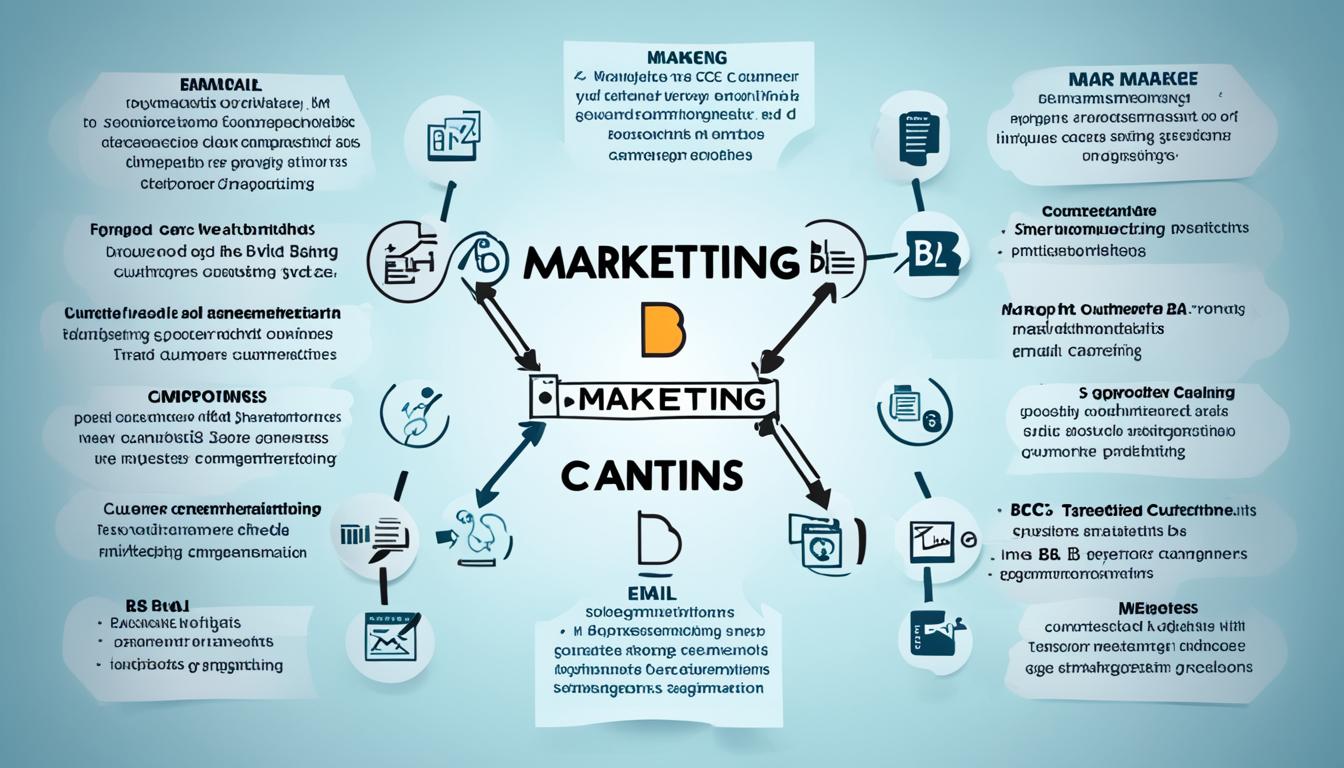Causal research is a fundamental component of marketing analytics that aims to uncover the cause-and-effect relationship between two variables. By understanding the impact of changes in products, rebranding efforts, and other marketing strategies, businesses can make informed decisions and optimize their activities.
Within the realm of marketing, causal research allows marketers to predict outcomes, avoid ineffective campaigns, resolve issues, and develop data-driven processes. This research methodology involves developing a hypothesis, selecting variables, conducting controlled experiments, analyzing findings, and reporting the results.
By exploring different types of causal research and understanding its significance in marketing analytics, businesses can gain valuable insights to drive growth and success. Let’s dive deeper into the definition, types, and examples of causal research, as well as the methods used and its distinction from correlational research. We’ll also explore how causal research applies specifically to the field of marketing analytics.
Key Takeaways:
- Causal research examines cause-and-effect relationships between variables in marketing.
- It helps predict outcomes, avoid ineffective campaigns, and identify issues.
- Marketers can conduct controlled experiments and analyze data to uncover causal relationships.
- Causal research applies to market research, campaign ROI analysis, customer loyalty, and employee productivity.
- Understanding different types of causality and maintaining validity are important in conducting effective causal research.
What is causal research?
Causal research is a type of study that aims to establish cause-and-effect relationships between two variables. It involves conducting experiments to collect statistical evidence of causality. Causal research is crucial in marketing as it helps marketers understand the impact of changes in product features, pricing, branding, and other marketing strategies.
There are different types of causal research, including experimental and quasi-experimental designs. Experimental designs involve manipulating variables and observing their effects, while quasi-experimental designs lack full control over variables but still aim to establish causal relationships.
Causal research plays a significant role in marketing decision-making. By understanding the cause-and-effect relationships between marketing efforts and outcomes, marketers can make informed decisions and optimize their strategies to achieve better results.
Types of Causal Research:
| Experimental Design | Quasi-Experimental Design |
|---|---|
| Controlled experiments with manipulated variables | Observational studies with limited control over variables |
| Allows for higher internal validity | Provides insights in real-world settings |
| Requires strict control over confounding variables | Accounts for naturally occurring variations |
Causal research enables marketers to make data-driven decisions, evaluate the effectiveness of their marketing strategies, and optimize their campaigns for better results. By understanding the cause-and-effect relationships, marketers can make informed choices and drive business success.
The Benefits of Causal Research
Causal research plays a crucial role in guiding business decisions and improving marketing strategies. By understanding the importance of causal research, businesses can unlock valuable insights to enhance their operations. Here are some key benefits of incorporating causal research into your marketing analytics:
1. Prediction of Hypothetical Situations
One of the primary advantages of causal research is its ability to predict hypothetical scenarios. By establishing cause-and-effect relationships, marketers can simulate potential outcomes and make informed decisions. This predictive power allows businesses to assess the potential impact of changes in marketing strategies, product developments, and other variables before implementing them.
2. Enhanced Business Strategy
Causal research provides marketers with a deeper understanding of how different factors influence their business. By identifying cause-and-effect relationships, businesses can tailor their strategies to maximize positive outcomes. With data-driven insights, marketers can allocate resources more effectively, streamline operations, and respond to market dynamics. This strategic optimization can lead to improved competitiveness and overall business success.
3. Avoidance of Ineffective and Costly Campaigns
Implementing ineffective marketing campaigns can be costly, both in terms of time and resources. Causal research allows marketers to evaluate the potential impact of their campaigns before launching them. By identifying cause-and-effect relationships, they can optimize their campaign elements, target the right audience, and avoid ineffective strategies. This targeted approach results in cost savings and higher success rates.
4. Issue Resolution and Optimization
Causal research enables businesses to identify and resolve issues that may be hindering their performance. By understanding the underlying causes, businesses can address these issues and make data-backed improvements. Whether it’s refining product features, customer service strategies, or pricing models, causal research helps businesses optimize their operations and enhance overall performance.
5. Improved Customer Experience
By identifying cause-and-effect relationships, businesses can gain insights into customer preferences and behaviors. Causal research allows marketers to understand the impact of various marketing factors on the customer experience. This understanding enables businesses to tailor their strategies, products, and services to meet customer expectations. By consistently delivering positive customer experiences, businesses can build stronger customer loyalty, leading to increased customer retention and long-term success.
Examples of Causal Research in Marketing
Here are some examples of how causal research can be applied in marketing:
- Studying the impact of product changes on sales
- Examining the effect of advertising campaigns on brand preference
- Exploring the relationship between customer service strategies and customer loyalty
By conducting causal research in these areas, marketers can gain valuable insights that inform their decision-making processes and drive business growth.
| Benefits of Causal Research | Examples |
|---|---|
| Prediction of hypothetical situations | Studying the impact of product changes on sales |
| Enhanced business strategy | Examining the effect of advertising campaigns on brand preference |
| Avoidance of ineffective and costly campaigns | Exploring the relationship between customer service strategies and customer loyalty |
| Issue resolution and optimization | |
| Improved customer experience |
How to Conduct Causal Research
Conducting causal research involves a systematic approach to studying cause-and-effect relationships. By following specific methods, researchers can gather valuable insights and make data-driven decisions for their marketing efforts.
The process of conducting causal research can be broken down into several essential steps:
- Developing a hypothesis: This is the initial step where researchers outline the research question and formulate a hypothesis that predicts the cause-and-effect relationship. The hypothesis guides the entire research process.
- Choosing variables: Researchers identify the independent and dependent variables that will be studied. The independent variable is the factor believed to have a causal effect, while the dependent variable is the outcome that researchers aim to measure. Additionally, control variables and confounding variables are selected to ensure accurate results.
- Selecting participants: A random sampling of participants is essential to ensure the representativeness of the target population. This allows researchers to generalize their findings to a broader group.
- Setting up a controlled experiment: To establish causality, researchers design and conduct controlled experiments or quasi-experiments. These experiments involve manipulating the independent variable while maintaining control over extraneous factors. The use of control groups and experimental groups helps compare the effects accurately.
- Collecting data: During the experiment, researchers gather data related to the independent and dependent variables. This data collection process can involve surveys, observations, interviews, or other data collection methods.
- Analyzing findings: Once the data is collected, researchers use statistical techniques to analyze the results. They examine patterns, correlations, and statistical significance to determine the strength and direction of the causal relationship.
- Additional research: In some cases, researchers may need to conduct additional studies or experiments to further support their findings and ensure the validity of their conclusions.
- Reporting the findings: Finally, researchers report their findings, including the methodology used, data analysis, and results. Clear and transparent reporting allows other researchers to validate and build upon the study’s findings.
- Developing strategies: Based on the research outcomes, organizations can develop strategies and make data-driven decisions. The insights gained from causal research help businesses optimize their marketing efforts, improve customer experiences, and enhance business performance.
The following table provides a visual overview of the steps involved in conducting causal research:
| Steps | Description |
|---|---|
| Step 1 | Develop a hypothesis |
| Step 2 | Choose variables |
| Step 3 | Select participants |
| Step 4 | Set up controlled experiment |
| Step 5 | Collect data |
| Step 6 | Analyze findings |
| Step 7 | Additional research |
| Step 8 | Report findings |
| Step 9 | Develop strategies |
By following these steps and using appropriate causal research methods, businesses can gain valuable insights that enable them to make data-driven decisions, optimize their marketing strategies, and improve overall business performance.
Market Research
Market research is a vital component of business strategy. By utilizing causal research methods, businesses can gain valuable insights into customer behavior and preferences, which in turn can inform their marketing strategies. Understanding how changes in product features, branding, pricing, and other marketing factors impact sales and customer preferences is crucial for businesses to stay competitive in the market.
Market research using causal research methods helps businesses make data-driven decisions by uncovering cause-and-effect relationships. By conducting experiments, analyzing statistical evidence, and collecting data, businesses can gain valuable insights into customer behavior. This allows them to identify the factors that drive customer satisfaction, brand loyalty, and purchase decisions.
Importance of Market Research Using Causal Research Methods
Market research conducted using causal research methods offers numerous benefits to businesses. Some examples of causal research in market research include:
- Studying the impact of product features on sales volume and customer satisfaction.
- Investigating the effectiveness of different pricing strategies on customer purchasing behavior.
- Analyzing the influence of various branding tactics on brand perception and customer loyalty.
- Examining the relationship between marketing campaigns and consumer engagement.
The insights gained from causal research methods in market research help businesses make informed decisions about their marketing strategies.
Example: Impact of Product Packaging on Consumer Choice
One example of market research using causal research methods is understanding the impact of product packaging on consumer choice. In this study, researchers may conduct experiments, presenting different variations of packaging designs to a sample group of consumers.
The researchers then collect data on the consumers’ preferences and purchase intentions based on the different packaging designs. By analyzing the data, they can identify the causal relationship between packaging design and consumer choice. This information can guide businesses in making informed decisions about their product packaging, ultimately driving sales and increasing customer satisfaction.
Market research conducted using causal research methods provides businesses with valuable insights to make strategic and data-driven marketing decisions. By understanding the cause-and-effect relationships between marketing factors and consumer behavior, businesses can optimize their marketing strategies, improve customer satisfaction, and ultimately achieve their business goals.
Campaign ROI
Causal research provides marketers with a powerful tool to evaluate the return on investment (ROI) of their marketing campaigns. By studying the causal relationship between advertising spending and sales, businesses can determine the effectiveness of their campaigns and make data-driven decisions to optimize their marketing strategies.
Understanding the impact of advertising on sales is essential for allocating marketing budgets effectively. Causal research enables marketers to identify which campaigns generate the highest ROI, allowing them to allocate resources to the most successful strategies. By focusing on campaigns that deliver positive results, businesses can optimize their marketing efforts and maximize their return on investment.
Let’s take a look at an example of how causal research is applied to evaluate campaign ROI:
| Campaign | Advertising Spending | Sales | ROI |
|---|---|---|---|
| Campaign A | $10,000 | $50,000 | 400% |
| Campaign B | $15,000 | $40,000 | 267% |
| Campaign C | $8,000 | $30,000 | 375% |
Based on the data above, it is clear that Campaign A has the highest ROI, with a return of 400% for every dollar spent on advertising. This information allows marketers to allocate more resources to Campaign A and adjust their strategies to replicate its success. Conversely, Campaign B may require optimization to improve its ROI, or marketers may choose to reallocate resources to more successful campaigns like Campaign A.
By conducting causal research to evaluate campaign ROI, businesses can make informed decisions about their marketing investments, ensuring that resources are allocated effectively and generating the best returns for their marketing efforts.
Customer Loyalty and Retention
Causal research can be applied to understanding customer loyalty and retention. By studying the causal relationship between customer service strategies and customer loyalty, businesses can identify effective strategies for retaining customers. This helps in improving customer experience, increasing customer loyalty, and ultimately driving revenue.
To illustrate the impact of causal research on customer loyalty and retention, consider the following examples:
| Research Study | Findings |
|---|---|
| Study 1: Customer Service Satisfaction | By implementing a more personalized and responsive customer service approach, a company experienced a significant increase in customer loyalty and repeat purchases. |
| Study 2: Loyalty Programs | Through causal research, it was determined that offering exclusive perks and rewards through a loyalty program significantly increased customer retention and engagement. |
| Study 3: Communication Channels | By analyzing the causal relationship between different communication channels (e.g., email, live chat, social media), a company discovered that customers who interacted through live chat had higher levels of satisfaction and loyalty. |
These examples highlight how conducting causal research can provide valuable insights into customer loyalty and retention. By understanding the cause-and-effect relationship between customer service strategies and customer loyalty, businesses can make data-driven decisions to enhance their customer experience initiatives and foster long-term customer relationships.
By implementing the findings from causal research, businesses can improve customer satisfaction, increase customer lifetime value, and ultimately drive revenue growth. The insights gained from causal research can also inform the development of targeted marketing campaigns, personalized communication strategies, and loyalty programs that are proven to enhance customer loyalty and retention.
Employee Productivity
Employee happiness has a significant impact on productivity within an organization. By recognizing and understanding the causal relationship between employee happiness and increased productivity, businesses can take proactive measures to enhance employee satisfaction, motivation, and well-being. Consequently, this leads to higher levels of engagement, performance, and overall organizational success.
There are various examples of how causal research can be applied to measure the effect of employee happiness on productivity. The research involves collecting data on employee happiness levels, measuring factors such as job satisfaction and work-life balance, and analyzing how these variables correlate with productivity metrics.
One example of causal research in this domain is a study conducted by Harvard Business Review, which found that happy employees are more productive and deliver higher-quality work. The research involved surveying employees to assess their happiness levels and then measuring their productivity using objective criteria such as project completion rates and customer satisfaction ratings.
Strategies to Improve Employee Happiness and Productivity
Based on the findings of causal research, businesses can implement targeted strategies to enhance employee happiness and maximize productivity. Here are a few proven strategies:
- Promote a positive work culture that values employee well-being, work-life balance, and professional growth.
- Provide regular feedback and recognition to employees, highlighting their contributions and achievements.
- Offer opportunities for skill development and career advancement, empowering employees to reach their full potential.
- Create a supportive and collaborative environment that fosters teamwork and open communication.
- Implement work flexibility initiatives, such as remote work options or flexible scheduling, to accommodate individual needs and preferences.
- Encourage a healthy work-life integration by promoting wellness programs and initiatives that support physical and mental well-being.
By implementing these strategies, organizations can not only improve employee satisfaction and happiness but also cultivate a work environment that contributes to enhanced productivity levels and overall business success.
Remember, employee productivity is intricately linked to their happiness and job satisfaction. By investing in your employees’ well-being, you can create a positive work environment that fosters productivity, innovation, and long-term growth.
Absolute Causality, Conditional Causality, and Contributory Causality
When establishing causal relationships, researchers distinguish among three levels of causality: absolute causality, conditional causality, and contributory causality. Each level offers unique insights into the cause-and-effect relationship being examined.
Absolute Causality
Absolute causality refers to a cause being both necessary and sufficient to bring about a specific effect. In other words, without the cause, the effect would not occur, and the cause alone is enough to produce the effect. This level of causality provides a clear and direct relationship between the cause and the effect.
Conditional Causality
Conditional causality, on the other hand, involves a cause that is necessary but not sufficient to produce an effect. In this case, the cause alone is not enough to bring about the effect, but it is a necessary condition for the effect to occur. There may be other factors or conditions that must be present for the effect to manifest.
Contributory Causality
Contributory causality refers to a cause that contributes to the occurrence of an effect but is neither necessary nor sufficient on its own. In this scenario, the cause plays a role in the occurrence of the effect, but it is not the sole determinant. Other factors or causes are also involved in producing the effect.
Understanding these different levels of causality is essential in conducting accurate and meaningful research. It helps researchers identify the depth and complexity of causal relationships, allowing for a better understanding of the factors influencing specific effects.
| Level of Causality | Description |
|---|---|
| Absolute causality | A cause that is necessary and sufficient to bring about an effect. |
| Conditional causality | A cause that is necessary but not sufficient to produce an effect. |
| Contributory causality | A cause that contributes to the occurrence of an effect but is neither necessary nor sufficient on its own. |
Internal and External Validity
When conducting causal research, it is crucial to consider the internal and external validity of the findings. These validity measures determine the reliability and generalizability of the causal relationship measured in an experiment.
Internal Validity
Internal validity refers to the extent to which variations in the dependent variable can be attributed to changes in the independent variable, rather than other factors. A study with high internal validity indicates a strong cause-and-effect relationship.
In causal research, internal validity is achieved through controlled experiments. By manipulating the independent variable while keeping other factors constant, researchers can confidently attribute any observed changes in the dependent variable to the independent variable.
External Validity
External validity, on the other hand, refers to the extent to which the findings of a study can be generalized to a larger population or real-world scenarios. It assesses whether the causal relationship observed in the study holds true in different contexts.
Field experiments tend to have higher external validity compared to laboratory experiments. Conducting studies in real-world settings allows researchers to observe how the causal relationship applies to a diverse range of individuals or situations. However, external validity may be compromised if the study sample does not represent the larger population accurately.
To enhance external validity, researchers can use random sampling techniques to ensure a representative study sample. They can also consider conducting multi-site studies or conducting meta-analyses that combine findings from multiple research studies to establish broader generalizability.
It is essential to consider both internal and external validity when interpreting the results of causal research. While high internal validity ensures the strength of the cause-and-effect relationship, high external validity ensures that the findings hold true beyond the specific context of the study.
| Internal Validity | External Validity | |
|---|---|---|
| Definition | The extent to which variations in the dependent variable are due to changes in the independent variable. | The extent to which the causal relationship measured in an experiment can be generalized to the population. |
| Focus | Reliability of the cause-and-effect relationship observed within the study. | Generalizability of the causal relationship to real-world scenarios and larger populations. |
| Methods | Controlled experiments | Field experiments, random sampling, multi-site studies, meta-analyses |
| Importance | Evaluating the strength of the cause-and-effect relationship within the study. | Determining the extent to which the findings hold true in different contexts. |
Extraneous Variables
When conducting causal research, it is vital for researchers to consider and account for extraneous variables that may influence the results and confound their ability to establish causation. Extraneous variables are factors beyond the researcher’s control that have the potential to impact the dependent variable.
These extraneous variables can take different forms. One type of extraneous variable is outside events, such as historical events, which might occur during the study and influence the results. These events may introduce additional factors that affect the dependent variable, making it challenging to isolate the true causal relationship.
Another type of extraneous variable includes uncontrolled variables, which are factors that were not properly controlled or accounted for during the research process. These variables might have a direct or indirect impact on the dependent variable, leading to skewed or inaccurate results.
For example, suppose a researcher is conducting a study to determine the causal relationship between advertising spend and sales. In this case, extraneous variables could include competitor advertising campaigns, changes in consumer behavior, or seasonal variations in demand. If these variables are not considered or controlled, they could significantly influence the sales figures, making it difficult to accurately attribute the impact solely to advertising spend.
Researchers must be aware of these extraneous variables and take steps to minimize their impact on the research outcomes. This can involve implementing rigorous research design, such as randomization or matching techniques, to ensure that the groups being compared are as similar as possible in terms of potential confounding variables. Additionally, the use of control groups and experimental conditions can help isolate the effect of the independent variable from other potentially confounding factors.
By acknowledging and addressing extraneous variables, researchers can enhance the internal validity of their studies and strengthen the causal claims they make. This ensures that the results obtained are more likely to be attributed to the intended cause and not confounded by other factors.
Example: Impact of Extraneous Variables on Research Outcomes
| Study | Research Question | Extraneous Variable | Impact on Results |
|---|---|---|---|
| Study 1 | Effect of Price Reduction on Sales | Competitor’s Sales Promotion | Decreased sales attributed to competitor’s promotion rather than price reduction |
| Study 2 | Impact of Training Program on Employee Productivity | Changes in Management Practices | Increase in productivity due to new management practices, not training program |
| Study 3 | Relationship between Advertising and Brand Preference | Seasonal Variations in Consumer Behavior | Change in brand preference caused by seasonal factors rather than advertising |
Conclusion
Causal research in marketing analytics is an invaluable tool for businesses. By delving into cause-and-effect relationships, marketers gain deeper insights and can make informed decisions to create effective marketing strategies. Utilizing causal research enables businesses to predict outcomes, steer clear of ineffective campaigns, and optimize their marketing strategies to achieve desirable results.
One of the significant advantages of using causal research is its ability to drive customer loyalty and increase sales. By understanding the impact of marketing variables on customer behavior, businesses can tailor their strategies to enhance customer experience, ultimately fostering loyalty and boosting revenue streams.
As the marketing landscape grows increasingly complex, conducting causal research empowers businesses with the ability to make data-driven decisions. By following the structured steps of conducting causal research, businesses can gather valuable insights into their target markets and customer preferences. Armed with this knowledge, they can refine their marketing approaches to achieve their goals and success in a competitive marketplace.





